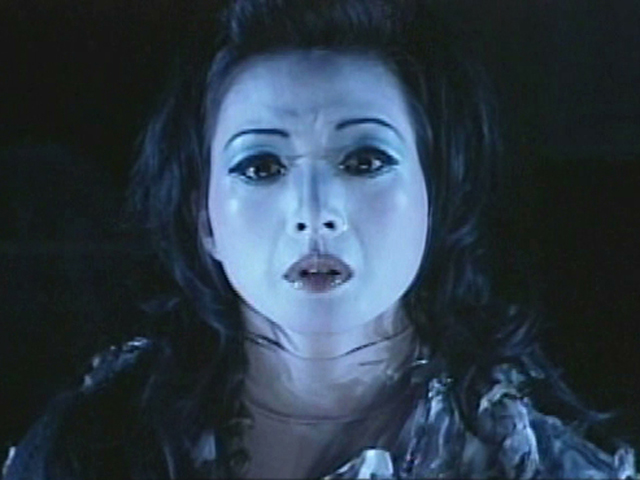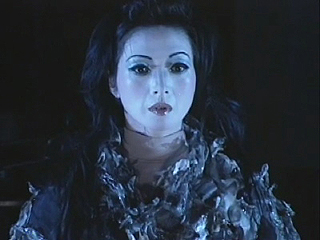About This Clip
Othello
Excerpt from Frontline, “Meditative Tragedy,” written by Gowri Ramnrayan, Volume 23 – Issue 03, Feb. 11 – 24, 2006
“Young Japanese director Satoshi Miyagi made meditative tragedy when he combined Othello with the ancient traditions of Mugen-Noh theatre. The text was no straight translation. An older form of Japanese – underscored by folk instruments – gave the play an elegiac rhythm. The use of masks ensured local flavour and universal relevance.
Cyprus was the setting. A waki (common man, here a Venetian pilgrim) is saddened to see the island under Turkish rule, with Venetian women enslaved by the conquerors. He meets the wandering shites (ghosts) of Desdemona and Othello. Heaven is shut to them. But narrating their experience to the waki cuts away their earthly shackles, sorrow and guilt. The detailing of their catastrophe becomes a community ritual leading to catharsis, repose and liberation.” – read more
Performed at Temporary outdoor Noh Stage in Japanese Garden at Tokyo National Museum and Kamani Auditorium at New Delhi, India
Performers: Maeshite, an Italian woman in Cyprus : Mikari (mover) / Sugiyama Natsumi (speaker), Tsure-1 Terauchi Ayako (mover) / Takii Miki (speaker), Tsure-2 Kataoka Sachiko (mover) / Susuki Haruyo (speaker), Tsure-3 Ikeda Makiko (mover) / Fuse Asuka (speaker), Waki, pilgrim from Venezia : Honda Maki, Othello: Abe Kazunori, Jiutai (chorus): Brabantio: Yoshiue Souichiro, Duke of Venice: Nakano Masaki, Iago: Otaka Koichi, Cassio: Daidomumon Yuya, Susuki Haruyo, Takii Miki, Fuse Asuka, Sugiyama Natsumi, Takazawa Rie, Hayashikata (musicians): Terauchi Ayako, Roderigo: Kato Yukio, Kataoka Sachiko, Ikeda Makiko, and Nochishite, Desdemona: Mikari
Translator / Scriptwriter: Adaptation: Hirakawa Sukehiro, Rendition: Odashima Yushi
Producer: Ku Na’uka Theatre Company
Designers: Lighting Designer: Osako Koji, Set Designer: Tanaka Tomoaki, Costume Designer: Takahashi Kayo (IMPRESSIVE), Hair and Makeup Designer: Kajita Kyoko (LES CINQ SENS), Music Composition: Tanakawa Hiroko, Sound: Mizumura Ryo, Chida Yumie (AZTEC), Stage Manager: Kotani Takeshi (K. OFFICE), Assistant Director: Onishi Ayako, and Administrator: Oishi Takako
Othello
Clips
Desdemona’s spirit in final dance
The characters Desdemona and Othello are embodied in one performer. The hand wearing the warrior glove represents Othello.
The characters Desdemona and Othello are embodied in one performer. The hand wearing the warrior glove represents Othello. less
Related Productions
- Moore – a Pacific Island Othello (Taft Mattos, Justina; 2020)
- Otelo (Othello) (Ríos, Claudia; 2009)
- Otelo (Othello) (Bittencourt, Jefferson; 2014)
- Othello (Perng, Ching-hsi)
- Othello: A Play in Black and White (Abel, Roysten; 1999)







The structure of this play is interesting. Telling the story from the viewpoint of a dead Othello and Desdemona is an interesting way to give individual perspective to the events. And using the story as a form of forgiveness is a interesting idea, although I am not sure I am willing to forgive Othello.
I really like this story by William Shakespeare, the video making is so beautiful and I didn’t have that much time to watch, really I need to spend some more time to watch this.
I had this chapter in my subject but visualization learning is far better then article reading thanks for this video.
Othello is widely considered one of Shakespeare’s greatest tragedies, exploring themes of jealousy, love, betrayal, and racism. Through the character of Othello, the play reveals the destructive power of jealousy and the tragic consequences that follow when it consumes the mind. Shakespeare’s masterful writing and characterization resonate with readers and audiences even today, making Othello a timeless classic that continues to captivate and challenge its audiences.